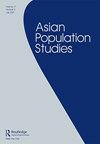蒙古最近的生育率变化:我们可以从检查节奏调整后的生育率中学到什么?
IF 1.5
4区 社会学
Q2 DEMOGRAPHY
引用次数: 3
摘要
1990年至2015年间,几个后共产主义国家的生育率下降,随后生育率上升,大约每名妇女生育一个孩子。蒙古就是一个很好的例子。1990年社会主义消亡后,日本的生育率进一步下降,但自2005年以来又有所上升,近年来在每个妇女生育3.0个孩子左右波动。政治因素被认为是这些变化的解释。本研究探讨人口因素是否也能解释蒙古时期生育率的变化。我们根据几项社会和人口调查收集的数据,按年龄和出生顺序重建生育率,以此来研究这一点。对生育率进行了调整,以检验节奏效应在近期生育率变化中的作用。结果表明,人口影响,特别是推迟生育和恢复生育,促成了蒙古最近生育率趋势和水平的变化。本文章由计算机程序翻译,如有差异,请以英文原文为准。
Recent fertility changes in Mongolia: what can we learn from examining tempo-adjusted fertility?
ABSTRACT Between 1990 and 2015, several post-communist countries experienced a decline in fertility, followed by a rise in the period fertility rate of roughly one child per woman. Mongolia is a good case-in-point. Its period fertility dropped further after the demise of socialism in 1990 but has increased again since 2005 and fluctuated around 3.0 children per woman in recent years. Political factors have been suggested as the explanation of these changes. This research investigates whether demographic factors also provide explanations for the period fertility changes in Mongolia. We study this through reconstructing the fertility rates, by age and birth order, from data collected by several social and demographic surveys. The fertility rates are adjusted to examine the role of tempo effects in recent fertility changes. The results show that the demographic influences, in particular childbearing postponement and recuperation, have contributed to recent changes in fertility trends and levels in Mongolia.
求助全文
通过发布文献求助,成功后即可免费获取论文全文。
去求助
来源期刊

Asian Population Studies
DEMOGRAPHY-
CiteScore
3.30
自引率
14.30%
发文量
12
期刊介绍:
The first international population journal to focus exclusively on population issues in Asia, Asian Population Studies publishes original research on matters related to population in this large, complex and rapidly changing region, and welcomes substantive empirical analyses, theoretical works, applied research, and contributions to methodology.
 求助内容:
求助内容: 应助结果提醒方式:
应助结果提醒方式:


